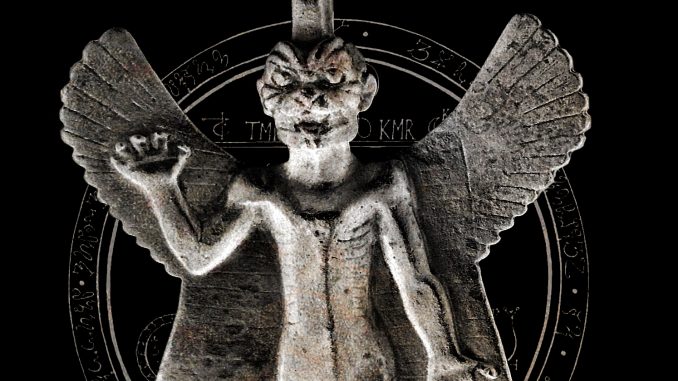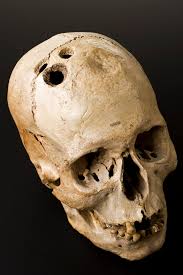
I received a copy of the book, Evil Archaeology: Demons, Possessions, and Sinister Relics (paid link), by Heather Lynn, PhD, from the publisher as a review copy. I actually had some high hopes for the book since its chosen topic has a lot of potential. It’s the sort of topic I would have loved to write a book on myself. I was quickly dismayed and disappointed, however, as the resulting work is 263 pages of nonsense. Initially, I thought I’d avoid writing a review altogether since it was so clearly one of those silly New Age beware-the-bump-in-the-night books not intended to be a scholarly work.
Then I remembered that the author very purposely included the letters, “PhD” after her name. With that inclusion, there’s no good reason not to take think this book wasn’t intended to be scholarly and, thus, deserving of a proper review.
The short version is that the book is mostly nonsense, wrapped up in a pretense of scholarship and academic production when, in fact, it is merely a half-assed mashup of just-so stories mixed with disparate and spurious tidbits of information that beg for context never to be found.
But let me show you a few examples.
Near the very beginning of the book, Heather Lynn writes, “drilling a permanent hole in the skull, or trepanning , is the oldest known surgical procedure, dating bck to the late Paleolithic era. Archaeologists have excavated the remains of a Neanderthal man at Mount Zagrou in Iraq, dating back at least 60,000 years.”
The only other place that uses the phrase “Mount Zagrou” or “Mt. Zagrou” is an EP Magazine article from the early 2000s.
EPM (European Pupils Magazine) is an international periodical about the History of Science and Technology, written by European students aged from 14 to 19.
The EP Magazine article reads:
The earliest evidence of surgery for the treatment of migraine is coming from a very old skeleton of a Neanderthal man found at Mount Zagrou in Iraq. Dated to 60,000 years ago and bearing signs of amputation of his right arm. This is the first known surgery in the skull which is a form of early trepanning. It was not drilling because they were schisms on the skull rather than holes, that this operation removed small pieces of bones of the skull with a knife.
EP Magazine, “Trepanning, an ancient technique” June 26, 2012.

Age Jericho, 2200-2000
BCE. Photo: Welcome Images
It seems likely that she obtained her “data” from an internet search on “early trepanning” (or something similar), which will return a result for the EP Magazine article by page 3 in Google. The things about the European Pupils Magazine that we need to keep in mind are: 1) this was a student-written online magazine with English-language content created by teenagers who were, 2) possibly not native English speakers. The Neanderthal specimen from Iraq dating to 60,000 years ago comes from Shanidar Cave in the Zagros Mountains of Iraq. Not “Mount Zagrou,” which might easily be a translation mistake.
At any rate, the students who wrote the EP Magazine article are hardly to be held accountable for the poor research of a “PhD” who would like his or her book to be accepted as a serious academic work. And this is assumed to be the case if you go to the trouble of creating an author bio that points out your expertise as an archaeologist, historian, and earner of a PhD.
And, in this first dozen pages of her book, Heather Lynn reveals that she is definitely not an archaeologist as she claims and is more interested in appealing to the sensational than educating the public. A genuine archaeologist, for instance, would not have been caught up in the sensation of the EP Magazine article and recognized Shanidar Cave as the site being referred to. And, even if she didn’t recall the details, a quick look at the works of Trinkaus or Stewart (two seminal works on the topic) would have offered clarity and accuracy to her account.
The Neanderthal individual at Shanidar Cave does, indeed, date back to 60,000 years; and it may, indeed, be among the earliest examples of surgery; but not for trepanation, but for the possible amputation of the arm.
Sometime prior to his death, Shanidar 1 sustained injuries to his right frontal and left orbit and a massive injury to his right side that resulted in arthritic degenerations of the right knee, ankle, and first tarsometatarsal joint, a fracture of the right fifth metatarsal, and extreme atrophy and/or hypotrophy of the right clavicle, scapula, and humérus with fractures and a possible amputation of the distal humérus.
From, Trinkaus, Erik (1983). The Shanidar Neandertals. New York: Academic Press, p. 20.
Stewart, likewise, mentions the possibly amputated arm and notes that it raises questions like was the forearm lost in an injury or amputated after a fracture? Neither author mentions any evidence of trepanning of these or any other Neanderthal remains. In fact, Lynn might have done well to stick with the information in the edited volume she later cites by Arnott, Finger, and Smith (2003) which includes an overview chapter that points out the oldest known trepanned skulls to date come from North Africa and the Levant, dating at around 10,000 BCE and 7,000 BCE respectively. This doesn’t mean earlier cultures didn’t do it–even Neanderthals. It just means we haven’t yet found evidence.
Lynn’s whole point about trepanned skulls, however, is to introduce the concept of “exorcism” or “releasing demons” as a hypothesis for the reasons such surgeries were done in antiquity. And this is where she mentions Paul Broca’s own hypothesis formulated during the 19th century. But the problem is that this is just a hypothesis. No clear evidence for the casting out of evil spirits, demons, devils or other superstitious motivations appear to exist in the archaeological record, however intuitive this hypothesis may be given extent of superstition within human cultures.

There are many things that Lynn flat out gets wrong in this book. Another example, and you needn’t be a scientist or archaeologist in order to fact check it, is her claim about injuries on the set of the 1973 film, The Exorcist. Your first question might be, “what does a 1970s horror movie have to do with archaeology. The answer is, well, not much. Other than the fact that the film opens with an archaeological dig in which an artifact depicting the demon Pazuzu was found.
In Lynn’s account, she claims (p. 138) that both Linda Blair, who plays the 12-year old, demon-possessed Regan, and Ellen Burstyn, who plays her mother, broke their backs during production of the movie. And Lynn cites Burstyn’s own book, apparently without having read it!
Linda Blair, who played Regan, had her back broken during an exorcism scene. Burstyn, who played Regans’ mother, also broke her back during filming.
Lynn, Heather (2019), page 138.
Yet, in her autobiographical account, Burstyn has something very different to say about Linda:
Even though her back was bruised, she did the scene again for other camera angles. Throughout this whole shoot she was incredibly brave.
Burstyn (2006), page 272.
And this to say about herself:
Everyone knew I was hurt. There was no doubt in anyone’s mind. I was carried to my dressing room. Doctors were called. nothing was broken, but everything was bruised.
Burstyn (2006), page 276
No broken backs.
This is the sort of pseudo-scholarship common throughout the book. And this story, Lynn’s version of it contextualized with the truth, is an excellent example of the intellectual laziness brought to her writing. Either Heather Lynn didn’t really read Burstyn’s account, and perhaps, even made it up of whole cloth; or she did read Burstyn’s account and chose a sensational story over a mundane truth.
She gets details so wrong they become new concepts, like the Zagros mountains becoming “Mt. Zagrou.”

Wikimedia/Wikicommons
Overall, this book by Heather Lynn PhD contains many spurious and disparate “facts” generally presented without regard for connecting them temporally, geographically, or even culturally. The sentence structure is often sloppy and unimaginative, presented in the pseudo-Socratic manner of sensationalist television programs like Ancient Aliens. In other words, she presents a spurious set of facts, some just-so stories that contain likes like “it’s been said…,” the follows with questions like, “could objects really contain evil?” or “could this artifact actually be cursed?”
While there were some interesting, genuine facts interspersed with the spurious and invented ones, there is just too much nonsense presented to accept this book as a genuine attempt to provide meaningful discussion on the concepts of evil and demons in the archaeological record. The author assumes a credible stance in spite of the weak attempts to appear Socratic and even offers the reader methods “to protect” from cursed objects, demons, or possession.
I do, however, give Lynn props for including the National Suicide Prevention Lifeline number and online web address for those suffering from mental illnesses often thought in the past to be signs of demon possession in the past. Though she still suggested that mental health professionals can put patients in touch with exorcists should they be needed. I would say if you have such a mental health “professional,” you might want to seek out a new one.
References and Further Reading
Burstyn, Ellen (2006). Lessons in Becoming Myself. New York: Riverhead Books, pp. 272, 276.
Finger, Stanley; and Clower, William T (2003). On the Birth of Trepanation: the Thoughts of Paul Broca and Victor Horsley. In, Arnott, Robert; Finger, Stanley; Smith, Chris (Eds), Trepanation: History, Discovery, Theory. The Netherlands: Swets & Zeitlinger, pp. 347-363.
Ferembach, D (1962). La Nécropole Epipaléolithique de Taforalt (Maroc Oriental, Etude de Squeleites Humains). Rabat: Centre National de la Recheriche Scientific.
Rose, Clifford (2003). An Overview of Neolithic Times to Broca. In, Arnott, Robert; Finger, Stanley; Smith, Chris (Eds), Trepanation: History, Discovery, Theory. The Netherlands: Swets & Zeitlinger, pp. 347-363.
According to her bio, she has an “associate degree in archaeology”, an MA in History (thesis had nothing to do with archaeology) and a PhD in Education. Claims to hold “certificates” in osteoarchaeology and archaeoastronomy from a couple of European schools. Her bio sounds like it was written by Scott Wolter or Graham Hancock: Lot’s of stuff about hidden histories and secret archaeological investigations supported by shadowy organizations. Deep academic corruption. And so on and so forth. Has appeared on Ancient Aliens and Coast to Coast AM, which pretty much says it all.
Heather Lynn is actually a pseudonym. I actually found her real Linked In profile, and I *think* it listed her education degree as a EdD. Not a PhD. If that’s the case, her fake name has a fake degree. Or at least one that’s not quite consistent with reality.
In fact, her Linked In shows:
Education
University of New England
Degree: Doctorate
Field Of Study: Education
Dissertation: Museum Technologies: A Phenomenological Study of The Adult Experience
Southern New Hampshire University
Degree: Master of Arts
Field Of Study: History
Thesis: Reading Between the Signs: The Impact of Literacy on the Development of Advertising in Early Modern Europe
Southern New Hampshire University
Degree: Bachelor of Arts
Field Of Study: Liberal Arts
Cuyahoga Community College
Degree: Associate of Arts
Field Of Study: Archaeology
Cuyahoga Community College
Degree: Certificate
Field Of Study: Advanced Leadership
Activities and Societies: A five-course certification and service program resulting in a certificate, CEUs, and induction into the League of Distinguished Certified Leaders.
That’s largely in line with the bio info on her blog page that I visited except for the certification that she claimed. Not sure on the Ph.D. versus EdD thing. I understand there is a difference but am not sure what it is. My wild guess is that the Ph.D is a more difficult program of study which might explain why someone with an EdD would say they are Ph.D.
I’m assuming that she edited out the woo stuff for her Linked profile. It gets pretty deep pretty fast on her personal blog.
Just the title should sell a lot of copies to the conspiracy minded.
I find it ironic how this came out 1/1/2020.As I saw the Demon Pazuzu on this date Yes, the thing might actually exist.The article including a certain Demon called Pazuzu. I believe I saw this particularly Demon as well. As two others I won’t name.
And what is the evidence that 1) you observed a demon, and 2) it was named Pazuzu, and 3) demons exist?
Carl Sagan smoked pot so you can’t prove that demons don’t exist.
Dang it! That logic utterly defeats me. I must concede.
I’m certainly in agreement with others here that smoking pot is bad for you; after all, among other side effects, it makes one see “pyramids on the moon”, “aliens in ancient Sumerian texts”, and “advanced life forms on Mars”. Those musings should tell you *something*, LOL….